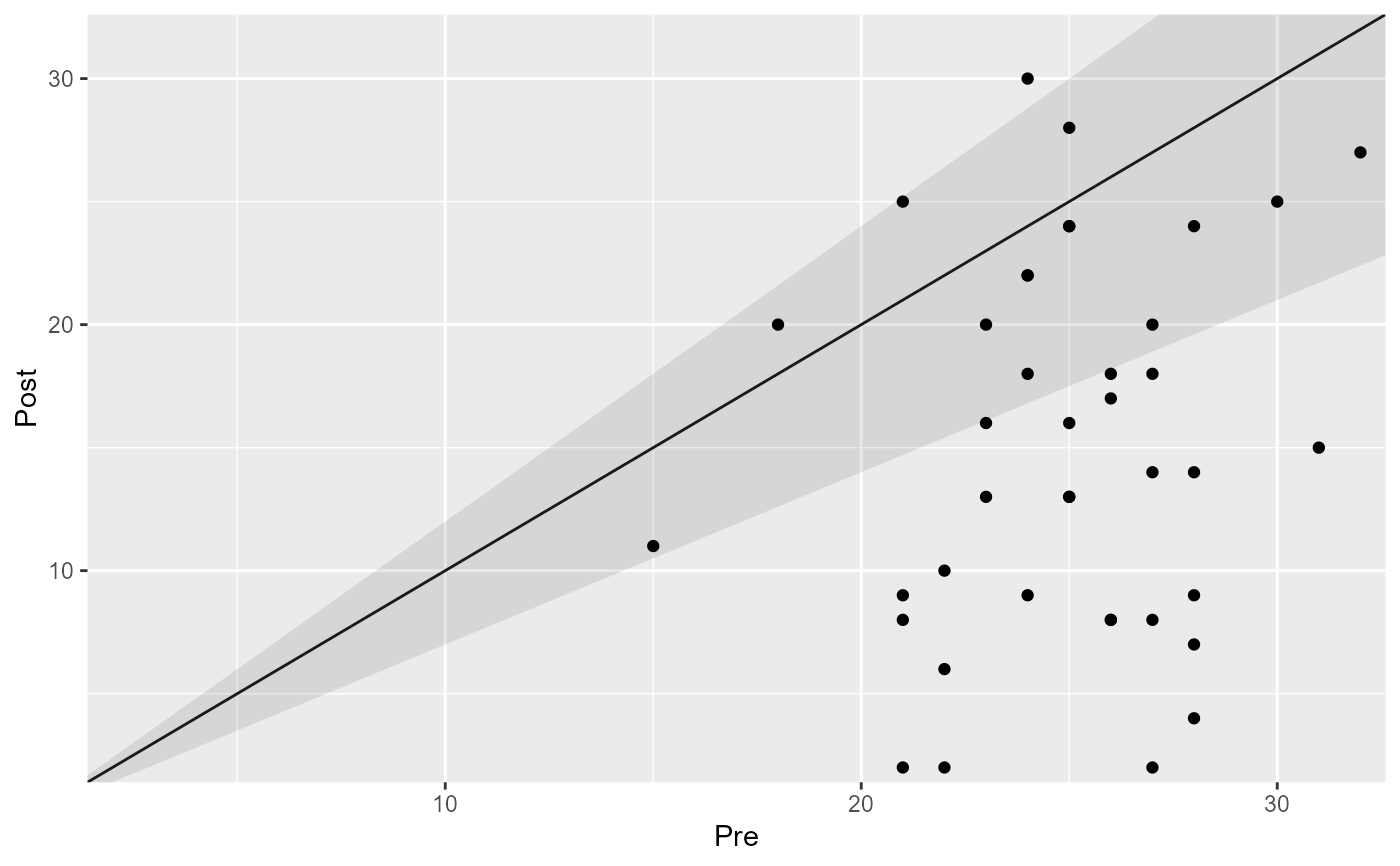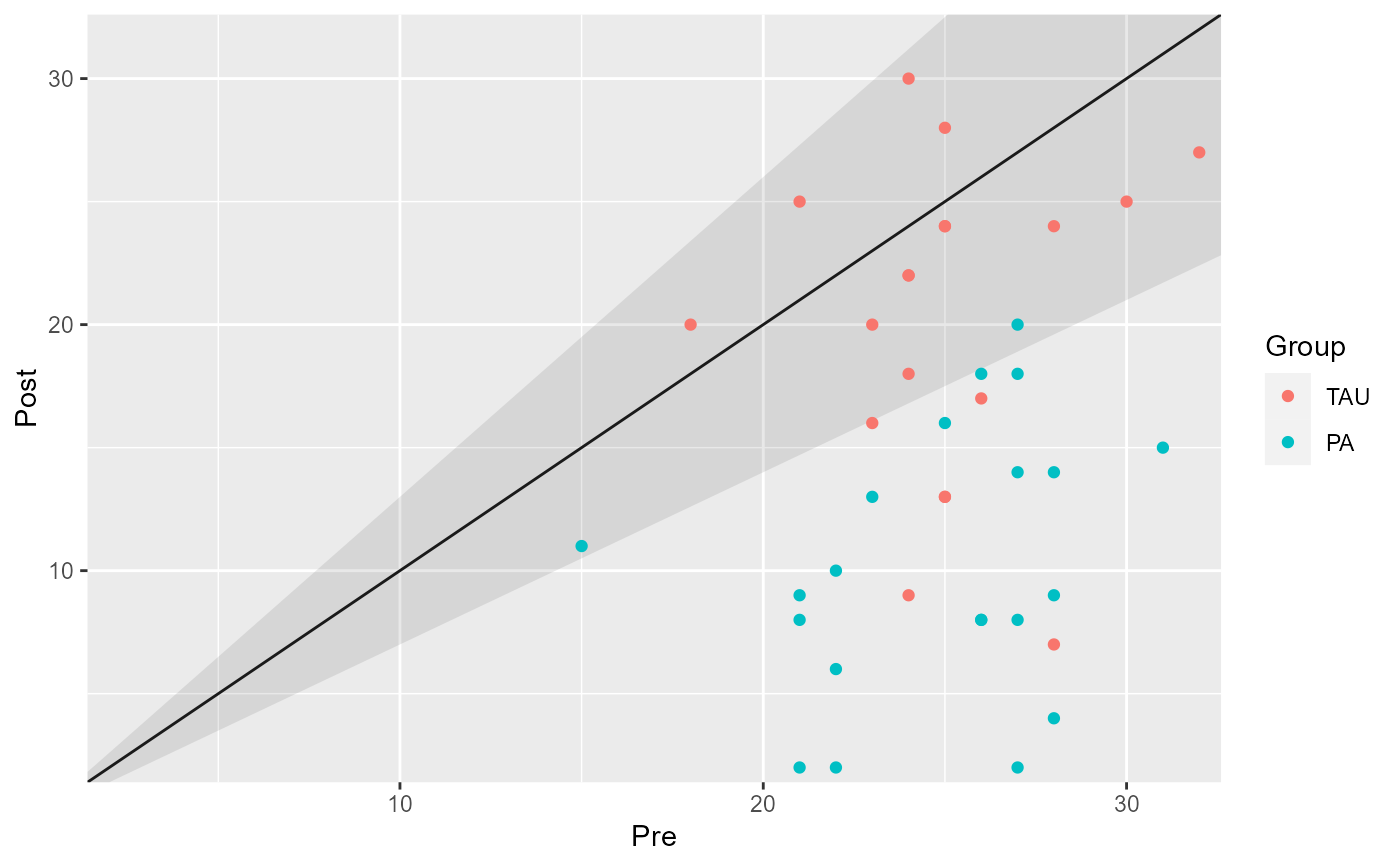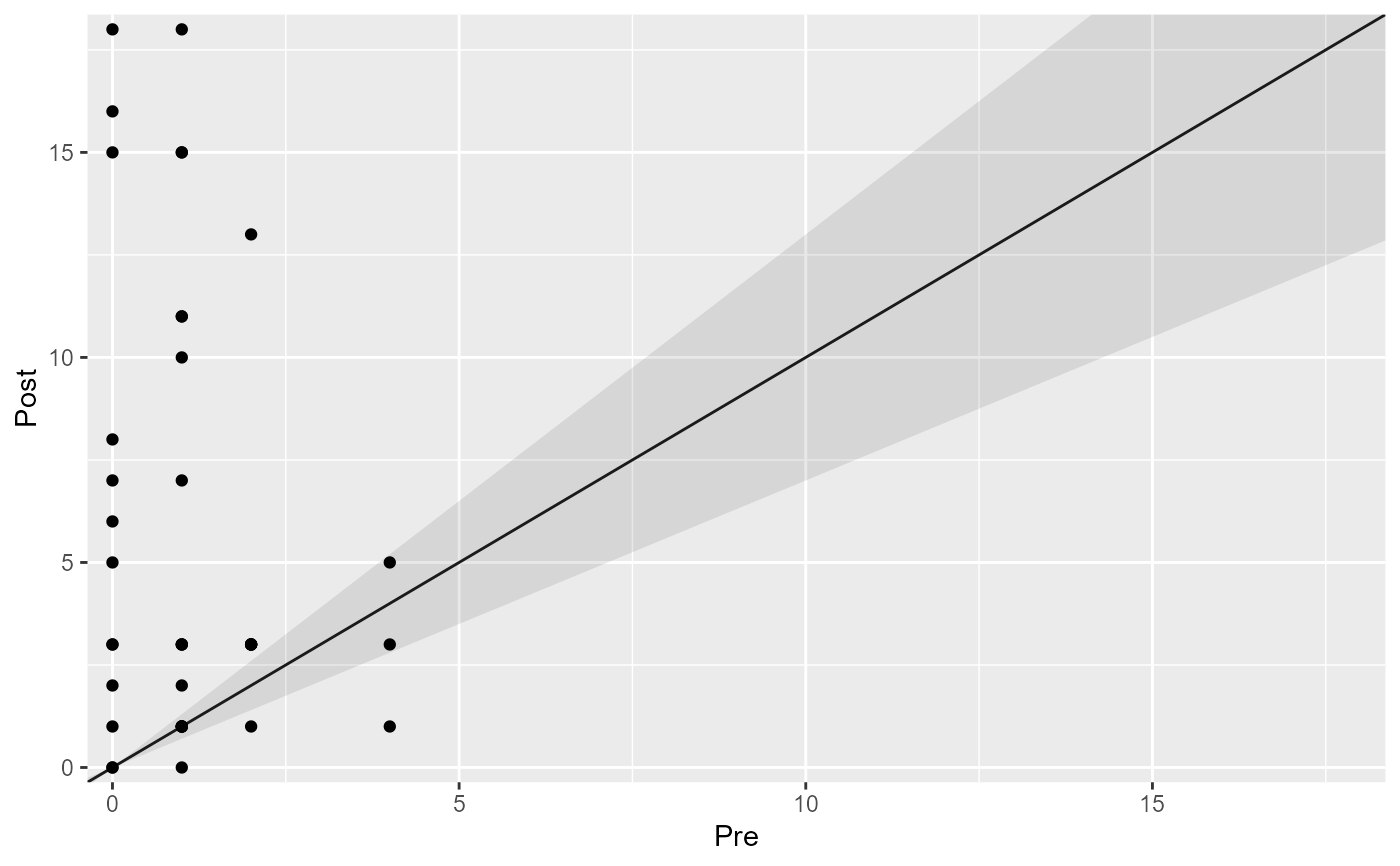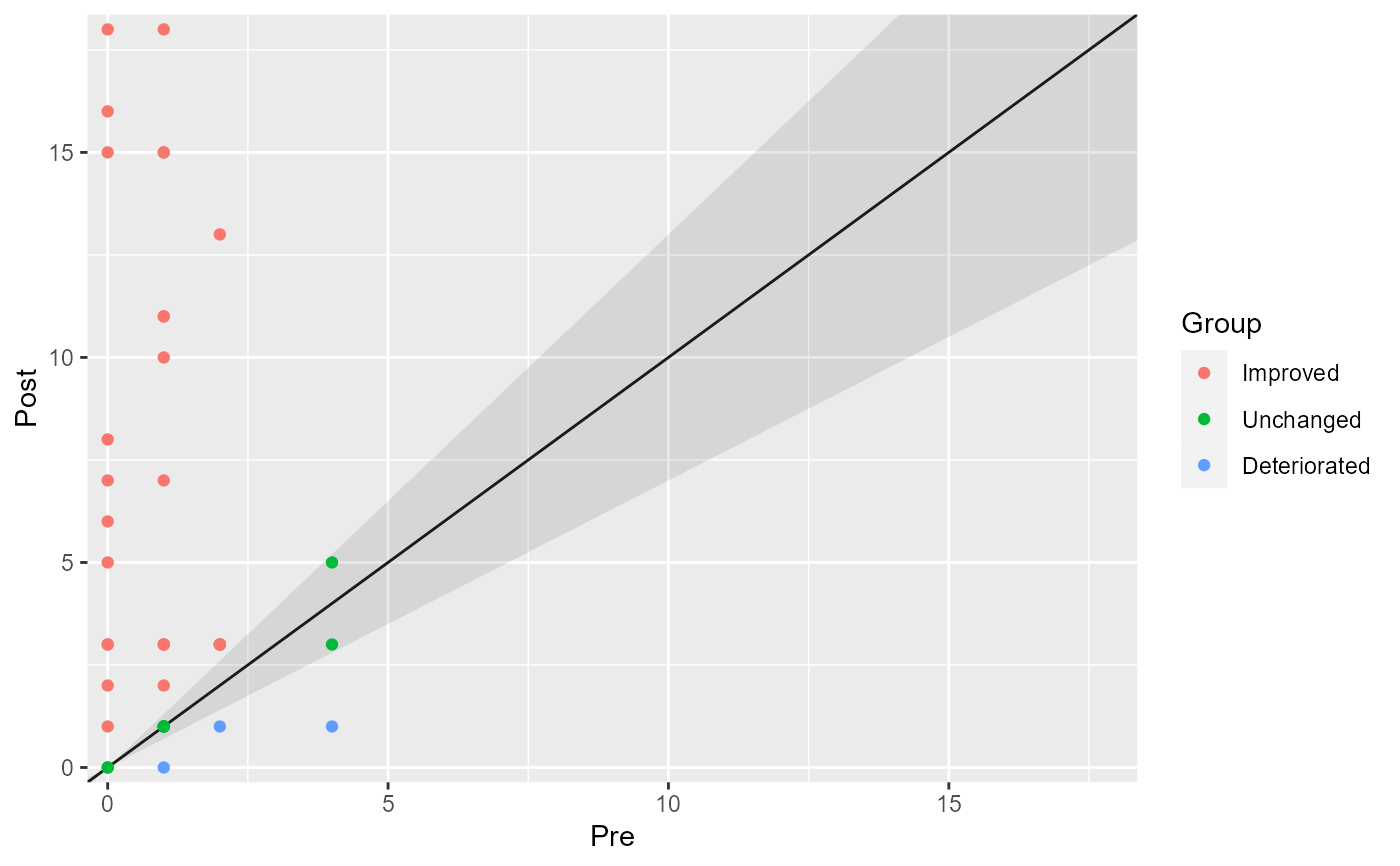cs_percentage() can be used to determine the clinical
significance of intervention studies employing the percentage-change
approach. For this, each individuals relative change compared to the pre
intervention measurement and if this change exceeds a predefined change in
percent points, this change is then deemed clinically significant.
Usage
cs_percentage(
data,
id,
time,
outcome,
group = NULL,
pre = NULL,
post = NULL,
pct_improvement = NULL,
pct_deterioration = NULL,
better_is = c("lower", "higher")
)Arguments
- data
A tidy data frame
- id
Participant ID
- time
Time variable
- outcome
Outcome variable
- group
Grouping variable (optional)
- pre
Pre measurement (only needed if the time variable contains more than two measurements)
- post
Post measurement (only needed if the time variable contains more than two measurements)
- pct_improvement
Numeric, percent change that indicates a clinically significant improvement
- pct_deterioration
Numeric, percent change that indicates a clinically significant deterioration (optional). If this is not set,
pct_deteriorationwill be assumed to be equal topct_improvement- better_is
Which direction means a better outcome for the used instrument? Available are
"lower"(lower outcome scores are desirable, the default) and"higher"(higher outcome scores are desirable)
Computational details
Each participants change is calculated and
then divided by the pre intervention score to estimate the individual's
percent change. A percent change for an improvement as well as a
deterioration can be provided separately and if pct_deterioration is not
set, it will be assumed to be the same as pct_improvement.
Categories
Each individual's change may then be categorized into one of the following three categories:
Improved, the change is greater than the predefined percent change in the beneficial direction
Unchanged, the change is within the predefined percent change
Deteriorated, the change is greater than the predefined percent change, but in the disadvantageous direction
Data preparation
The data set must be tidy, which corresponds to a long data frame in general. It must contain a patient identifier which must be unique per patient. Also, a column containing the different measurements and the outcome must be supplied. Each participant-measurement combination must be unique, so for instance, the data must not contain two "After" measurements for the same patient.
Additionally, if the measurement column contains only two values, the first
value based on alphabetical, numerical or factor ordering will be used as
the pre measurement. For instance, if the column contains the
measurements identifiers "pre" and "post" as strings, then "post"
will be sorted before "pre" and thus be used as the "pre" measurement.
The function will throw a warning but generally you may want to explicitly
define the "pre" and "post" measurement with arguments pre and
post. In case of more than two measurement identifiers, you have to
define pre and post manually since the function does not know what your
pre and post intervention measurements are.
If your data is grouped, you can specify the group by referencing the grouping variable (see examples below). The analysis is then run for every group to compare group differences.
See also
Main clinical signficance functions
cs_anchor(),
cs_combined(),
cs_distribution(),
cs_statistical()
Examples
cs_results <- claus_2020 |>
cs_percentage(
id,
time,
hamd,
pre = 1,
post = 4,
pct_improvement = 0.3
)
cs_results
#>
#> ── Clinical Significance Results ──
#>
#> Percentage-change approach with a 30% decrease in instrument scores indicating
#> a clinical significant improvement.
#>
#> Category | n | Percent
#> ---------------------------
#> Improved | 25 | 62.50%
#> Unchanged | 15 | 37.50%
#> Deteriorated | 0 | 0.00%
summary(cs_results)
#>
#> ── Clinical Significance Results ──
#>
#> Percentage-change analysis of clinical significance with a 30% decrease in
#> instrument scores indicating a clinical significant improvement.
#>
#> There were 43 participants in the whole dataset of which 40 (93%) could be
#> included in the analysis.
#>
#>
#> ── Individual Level Results
#>
#> Category | n | Percent
#> ---------------------------
#> Improved | 25 | 62.50%
#> Unchanged | 15 | 37.50%
#> Deteriorated | 0 | 0.00%
plot(cs_results)
 # You can set different thresholds for improvement and deterioration
cs_results_2 <- claus_2020 |>
cs_percentage(
id,
time,
hamd,
pre = 1,
post = 4,
pct_improvement = 0.3,
pct_deterioration = 0.2
)
cs_results_2
#>
#> ── Clinical Significance Results ──
#>
#> Percentage-change approach with a 30% decrease in instrument scores indicating
#> a clinical significant improvement and a 20% increase in instrument scores
#> indicating a clinical significant deterioration.
#>
#> Category | n | Percent
#> ---------------------------
#> Improved | 25 | 62.50%
#> Unchanged | 14 | 35.00%
#> Deteriorated | 1 | 2.50%
summary(cs_results_2)
#>
#> ── Clinical Significance Results ──
#>
#> Percentage-change analysis of clinical significance with a 30% decrease in
#> instrument scores indicating a clinical significant improvement and a 20%
#> increase in instrument scores indicating a clinical significant deterioration.
#>
#> There were 43 participants in the whole dataset of which 40 (93%) could be
#> included in the analysis.
#>
#>
#> ── Individual Level Results
#>
#> Category | n | Percent
#> ---------------------------
#> Improved | 25 | 62.50%
#> Unchanged | 14 | 35.00%
#> Deteriorated | 1 | 2.50%
plot(cs_results_2)
# You can set different thresholds for improvement and deterioration
cs_results_2 <- claus_2020 |>
cs_percentage(
id,
time,
hamd,
pre = 1,
post = 4,
pct_improvement = 0.3,
pct_deterioration = 0.2
)
cs_results_2
#>
#> ── Clinical Significance Results ──
#>
#> Percentage-change approach with a 30% decrease in instrument scores indicating
#> a clinical significant improvement and a 20% increase in instrument scores
#> indicating a clinical significant deterioration.
#>
#> Category | n | Percent
#> ---------------------------
#> Improved | 25 | 62.50%
#> Unchanged | 14 | 35.00%
#> Deteriorated | 1 | 2.50%
summary(cs_results_2)
#>
#> ── Clinical Significance Results ──
#>
#> Percentage-change analysis of clinical significance with a 30% decrease in
#> instrument scores indicating a clinical significant improvement and a 20%
#> increase in instrument scores indicating a clinical significant deterioration.
#>
#> There were 43 participants in the whole dataset of which 40 (93%) could be
#> included in the analysis.
#>
#>
#> ── Individual Level Results
#>
#> Category | n | Percent
#> ---------------------------
#> Improved | 25 | 62.50%
#> Unchanged | 14 | 35.00%
#> Deteriorated | 1 | 2.50%
plot(cs_results_2)
 # You can group the analysis by providing a group column from the data
cs_results_grouped <- claus_2020 |>
cs_percentage(
id,
time,
hamd,
pre = 1,
post = 4,
pct_improvement = 0.3,
group = treatment
)
cs_results_grouped
#>
#> ── Clinical Significance Results ──
#>
#> Percentage-change approach with a 30% decrease in instrument scores indicating
#> a clinical significant improvement.
#>
#> Group | Category | n | Percent
#> -----------------------------------
#> TAU | Improved | 6 | 15.00%
#> TAU | Unchanged | 13 | 32.50%
#> TAU | Deteriorated | 0 | 0.00%
#> PA | Improved | 19 | 47.50%
#> PA | Unchanged | 2 | 5.00%
#> PA | Deteriorated | 0 | 0.00%
summary(cs_results_grouped)
#>
#> ── Clinical Significance Results ──
#>
#> Percentage-change analysis of clinical significance with a 30% decrease in
#> instrument scores indicating a clinical significant improvement.
#>
#> There were 43 participants in the whole dataset of which 40 (93%) could be
#> included in the analysis.
#>
#>
#> ── Individual Level Results
#>
#> Group | Category | n | Percent
#> -----------------------------------
#> TAU | Improved | 6 | 15.00%
#> TAU | Unchanged | 13 | 32.50%
#> TAU | Deteriorated | 0 | 0.00%
#> PA | Improved | 19 | 47.50%
#> PA | Unchanged | 2 | 5.00%
#> PA | Deteriorated | 0 | 0.00%
plot(cs_results_grouped)
# You can group the analysis by providing a group column from the data
cs_results_grouped <- claus_2020 |>
cs_percentage(
id,
time,
hamd,
pre = 1,
post = 4,
pct_improvement = 0.3,
group = treatment
)
cs_results_grouped
#>
#> ── Clinical Significance Results ──
#>
#> Percentage-change approach with a 30% decrease in instrument scores indicating
#> a clinical significant improvement.
#>
#> Group | Category | n | Percent
#> -----------------------------------
#> TAU | Improved | 6 | 15.00%
#> TAU | Unchanged | 13 | 32.50%
#> TAU | Deteriorated | 0 | 0.00%
#> PA | Improved | 19 | 47.50%
#> PA | Unchanged | 2 | 5.00%
#> PA | Deteriorated | 0 | 0.00%
summary(cs_results_grouped)
#>
#> ── Clinical Significance Results ──
#>
#> Percentage-change analysis of clinical significance with a 30% decrease in
#> instrument scores indicating a clinical significant improvement.
#>
#> There were 43 participants in the whole dataset of which 40 (93%) could be
#> included in the analysis.
#>
#>
#> ── Individual Level Results
#>
#> Group | Category | n | Percent
#> -----------------------------------
#> TAU | Improved | 6 | 15.00%
#> TAU | Unchanged | 13 | 32.50%
#> TAU | Deteriorated | 0 | 0.00%
#> PA | Improved | 19 | 47.50%
#> PA | Unchanged | 2 | 5.00%
#> PA | Deteriorated | 0 | 0.00%
plot(cs_results_grouped)
 # The analyses can be performed for positive outcomes as well, i.e., outcomes
# for which a higher value is beneficial
cs_results_who <- claus_2020 |>
cs_percentage(
id,
time,
who,
pre = 1,
post = 4,
pct_improvement = 0.3,
better_is = "higher"
)
cs_results_who
#>
#> ── Clinical Significance Results ──
#>
#> Percentage-change approach with a 30% increase in instrument scores indicating
#> a clinical significant improvement.
#>
#> Category | n | Percent
#> ---------------------------
#> Improved | 28 | 70.00%
#> Unchanged | 9 | 22.50%
#> Deteriorated | 3 | 7.50%
summary(cs_results_who)
#>
#> ── Clinical Significance Results ──
#>
#> Percentage-change analysis of clinical significance with a 30% increase in
#> instrument scores indicating a clinical significant improvement.
#>
#> There were 43 participants in the whole dataset of which 40 (93%) could be
#> included in the analysis.
#>
#>
#> ── Individual Level Results
#>
#> Category | n | Percent
#> ---------------------------
#> Improved | 28 | 70.00%
#> Unchanged | 9 | 22.50%
#> Deteriorated | 3 | 7.50%
plot(cs_results_who)
# The analyses can be performed for positive outcomes as well, i.e., outcomes
# for which a higher value is beneficial
cs_results_who <- claus_2020 |>
cs_percentage(
id,
time,
who,
pre = 1,
post = 4,
pct_improvement = 0.3,
better_is = "higher"
)
cs_results_who
#>
#> ── Clinical Significance Results ──
#>
#> Percentage-change approach with a 30% increase in instrument scores indicating
#> a clinical significant improvement.
#>
#> Category | n | Percent
#> ---------------------------
#> Improved | 28 | 70.00%
#> Unchanged | 9 | 22.50%
#> Deteriorated | 3 | 7.50%
summary(cs_results_who)
#>
#> ── Clinical Significance Results ──
#>
#> Percentage-change analysis of clinical significance with a 30% increase in
#> instrument scores indicating a clinical significant improvement.
#>
#> There were 43 participants in the whole dataset of which 40 (93%) could be
#> included in the analysis.
#>
#>
#> ── Individual Level Results
#>
#> Category | n | Percent
#> ---------------------------
#> Improved | 28 | 70.00%
#> Unchanged | 9 | 22.50%
#> Deteriorated | 3 | 7.50%
plot(cs_results_who)
 plot(cs_results_who, show = category)
plot(cs_results_who, show = category)

